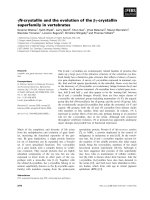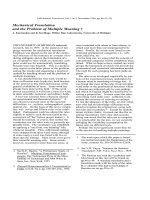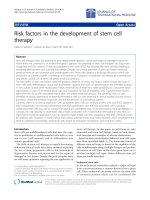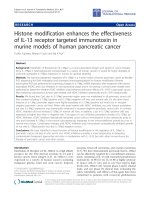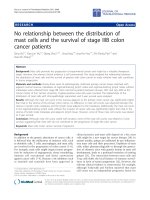Báo cáo sinh học: " Evolutionary genomics and the reach of selection" pps
Bạn đang xem bản rút gọn của tài liệu. Xem và tải ngay bản đầy đủ của tài liệu tại đây (143.42 KB, 5 trang )
Opinion
EEvvoolluuttiioonnaarryy ggeennoommiiccss aanndd tthhee rreeaacchh ooff sseelleeccttiioonn
Laurence D Hurst
Address: Department of Biology and Biochemistry, University of Bath, Bath, Somerset BA2 7AY, UK. Email:
Why is studying the way that genes and genomes evolve
interesting? There are many generally accepted answers.
Looking for places in a genome that are highly conserved is
an efficient means to locate functionally important
sequences, usually genes or gene regulatory domains.
Conversely, unusually fast-evolving sequences can suggest
where Darwinian selection might have acted to cause
important differences between species. We can discover
which gene families can be easily expanded or lost, which
species are related to which others, and where genes have
been transferred horizontally between species rather than
being transmitted by descent. But if you ask me what I think
is especially interesting about evolutionary genomics then
let me give a bit of history.
In the 1970s and 80s there was a large school of evolu-
tionary biology, much of it focused on understanding
animal behavior, that to a first approximation assumed that
whatever trait was being looked at was the product of
selection. Richard Dawkins is probably the most widely
known advocate for this school of thought, John Maynard
Smith and Bill (WD) Hamilton its main proponents. The
game played in this field was one in which ever more
ingenious selectionist hypotheses would be put forward and
tested. The possibility that selection might not be the
answer was given short shrift.
By contrast, during the same period non-selectionist theories
were gaining ground as the explanatory principle for details
seen at the molecular level. According to these models,
chance plays an important part in determining the fate of a
new mutation - whether it is lost or spreads through a
population. Just as a neutrally buoyant particle of gas has an
equal probability of diffusing up or down, so too in Motoo
Kimura’s neutral theory of molecular evolution an allele with
no selective consequences can go up or down in frequency,
and sometimes replace all other versions in the population
(that is, it reaches fixation). An important extension of the
neutral theory (the nearly-neutral theory) considers alleles
that can be weakly deleterious or weakly advantageous. The
important difference between the two theories is that in a
very large population a very weakly deleterious allele is
unlikely to reach fixation, as selection is given enough
opportunity to weed out alleles of very small deleterious
effects. By contrast, in a very small population a few chance
events increasing the frequency of an allele can be enough for
fixation. More generally then, in large populations the odds
are stacked against weakly deleterious mutations and so
selection should be more efficient in large populations.
In this framework, mutations in protein-coding genes that
are synonymous - that is, that replace one codon with
another specifying the same amino acid and, therefore, do
AAbbssttrraacctt
Unexpected findings in evolutionary genomics both question the role of selection in genome
evolution and clarify how genomes work.
Journal of Biology
2009,
88::
12
Published: 23 February 2009
Journal of Biology
2009,
88::
12 (doi:10.1186/jbiol113)
The electronic version of this article is the complete one and can be
found online at />© 2009 BioMed Central Ltd
not affect the protein - or mutations in the DNA between
genes (intergene spacers) are assumed to be unaffected by
selection. Until recently, a neutralist position has domi-
nated thinking at the genomic/molecular level. This is
indeed reflected in the use of the term ‘junk DNA’ to
describe intergene spacer DNA.
These two schools of thought then could not be more
antithetical. And this is where genome evolution comes in.
The big question for me is just what is the reach of selection.
There is little argument about selection as the best
explanation for gross features of organismic anatomy. But
what about more subtle changes in genomes? Population
genetics theory can tell you that, in principle, selection will
be limited when the population comprises few individuals
and when the strength of selection against a deleterious
mutation is small. But none of this actually tells you what
the reach of selection is, as a priori we do not know what the
likely selective impact of any given mutation will be, not
least because we cannot always know the consequences of
apparently innocuous changes. The issue then becomes
empirical, and genome evolution provides a plethora of
possible test cases. In examining these cases we can hope to
uncover not just what mutations selection is interested in,
but also to discover why, and in turn to understand how
genomes work. Central to the issue is whether our genome
is an exquisite adaption or a noisy error-prone mess.
TThhee ccoonntteesstt bbeettwweeeenn ffuunnccttiioonn aanndd nnooiissee
Consider, for example, the problem of transcription.
Although maybe only 5% of the human genome comprises
genes encoding proteins, the great majority of the DNA in
our genome is transcribed into RNA [1]. In this the human
genome is not unusual. But is all this transcription
functionally important? The selectionist model would
propose that the transcription is physiologically relevant.
Maybe the transcripts specify previously unrecognized
proteins. If not, perhaps the transcripts are involved in RNA-
level regulation of other genes. Or the process of
transcription may be important in keeping the DNA in a
configuration that enables or suppresses transcription from
closely linked sites.
The alternative model suggests that all this excess trans-
cription is unavoidable noise resulting from promiscuity of
transcription-factor binding. A solid defense can be given
for this. If you take 100 random base pairs of DNA and ask
what proportion of the sequence matches some
transcription factor binding site in the human genome, you
find that upwards of 50% of the random sequence is
potentially bound by transcription factors and that there
are, on average, 15 such binding sites per 100 nucleotides.
This may just reflect our poor understanding of
transcription factor binding sites, but it could also mean
that our genome is mostly transcription factor binding site.
If so, transcription everywhere in the genome is just so
much noise that the genome must cope with.
The problem of alternative transcripts is very similar. In the
original view of the gene, one gene made one transcript,
which made one protein. For many organisms (such as
bacteria and yeast) this model is still pretty good. For us it
isn’t. Latest estimates suggest that the vast majority of human
protein-coding genes can make many different (alternative)
messenger RNA molecules from a single transcript. In no
small part this is achieved by the cleavage and splicing of
one transcript in many different ways, each producing a
different set of protein-coding sections (exons), the non-
coding sections (introns) being removed (Figure 1). But
why this richness? Again, a good case can be made for both
the selectionist and the noise view.
A selectionist model would suppose that each transcript has
a role and is made when and where it is needed. In
Drosophila, different splicing of transcripts from genes in the
sex-determination pathway in males and females is central
to the establishment of sex differences in development,
suggesting that in this case exact coordination is critical.
Similarly, many human genes are differently spliced in
neurons, so producing ion channels with different sequences
and different biophysical or regulatory properties. Alterna-
tively, splicing may be inherently error-prone and many of
these alternatives may be just so much rubbish. Again a
defense can be given. The human genome is unusual in
having many and large introns. Finding small exons in the
sea of non-protein-coding material must be a formidable
computational task for our cells and hence is potentially
error-prone.
Recently, some evidence has been presented to support the
noisy splice model. The single-celled protist Paramecium has
short introns, some of which contain stop codons. Interest-
ingly, introns that are a multiple of three nucleotides long
are much more likely to contain a stop than those that are
not [2]. Why might this be? Paramecium, like other eukary-
otes, has a system called nonsense-mediated decay that
eliminates mRNAs that contain a stop codon where they
should not have one - it is, in effect, a quality-control mecha-
nism. As codons are three nucleotides long, if an intron that
is not a multiple of three long is not removed, it will induce
a change in the reading frame (a frameshift) and is likely to
make an mRNA with an out-of-place stop codon; this mRNA
will be removed by the quality-control system (Figure 1a).
One that is a multiple of three, however, will not induce a
frameshift (Figure 1b). To remove these transcripts would
12.2
Journal of Biology
2009, Volume 8, Article 12 Hurst />Journal of Biology
2009,
88::
12
require a stop codon in the intron as a fail-safe measure
(Figure 1c). The excess of stop codons in introns that are
multiples of three is hence parsimoniously explained if we
suppose splicing to be inherently error-prone.
A very direct measure of noise is variation in the expression
level of the same gene in many otherwise identical cells. For
some genes, there is a lot of variation, given the mean
abundance, for others much less. In yeast, for example,
‘essential’ proteins (those whose absence is lethal) tend to
have low-noise expression [3]. Other proteins, notably
those for the import of metabolites from the environment
into the cell, tend to be very noisy. Is this between-gene
variation in noise itself adaptive? A priori, essential genes
would be expected to be tightly regulated and to have low
variation in expression: if levels of the protein accidentally
slip too low, the cell might die. Does the noise of highly
noisy genes exist to enable a response to a variable environ-
ment - or because selection doesn’t care?
Two favorite examples from my laboratory bear on issues
on which confident neutralist statements were common-
place: that selection will not affect synonymous mutations
in mammals and that the location of genes in the genome is
irrelevant. We found that in regard to synonymous muta-
tions the strict-neutralist position is hard to substantiate in
mammals, but for previously unrecognized reasons.
Mammalian genes are unusual in having a very low ratio of
coding sequence to intronic DNA. This presents our cellular
machinery with an unusual problem, namely correctly
identifying the ends of numerous small exons. The solution
mammals appear to have reached is to allow a specific class
of proteins (SR proteins) to bind in immature RNA to exonic
splice enhancer (ESE) motifs, these being located
predominantly at the ends of exons [4]. The need to specify
these motifs, however, ensures that many synonymous
mutations are under probably strong selection, as failure of
splicing is potentially highly deleterious [5]. Indeed, upwards
of 40 diseases are associated with synonymous mutations
that disrupt splicing [5]. Both the choice of which codon to
use and rates of evolution of synonymous sites [6] are
affected by the need to specify ESEs.
The issue of gene location gets to the heart of the
relationship between genome organization and the control
of gene expression. The simplest model supposes that a
gene with its relevant upstream control elements is enough
to dictate expression of that gene. Those working on
transgenes (genes inserted by researchers into a genome)
know from experience that this is a limited model, as most
new transgene inserts will not be expressed appropriately, if
at all. There is now abundant evidence that within a
genome, genes with similar expression patterns cluster
together [7] - that is, they are syntenic. Whether this reflects
selection or noise remains the key issue. A simple model
supposes that most DNA in any given cell type is packaged
in such a way as to be largely unavailable for transcription.
The unpacking of the DNA to enable expression from one
/>Journal of Biology
2009, Volume 8, Article 12 Hurst 12.3
Journal of Biology
2009,
88::
12
FFiigguurree 11
The protist Paramecium has short introns in which some contain stop codons. Introns in multiples of threes are more likely to contain a stop codon
as a fail-safe measure for correct splicing.
((aa))
The failure in removal of an intron that is not a multiple of three will cause a frameshift and this will
most likely introduce an out of place stop codon in the resulting mRNA. This transcript can then be degraded by nonsense mediated decay (NMD).
((bb))
When an intron that is a multiple of three long is not removed, it will not cause a frameshift and therefore the mis-spliced transcript will not be
degraded.
((cc))
This can be overcome by having stop codons in introns of multiple of three. Therefore when the intron is not removed, NMD can act
on the incorrectly placed stop codon and remove the transcript.
Transcript degraded
Transcript not degraded
Transcript degraded
(a) Nucleotides in intron
are not a mulitple of 3
(b) Nucleotides in intron
are a mulitple of 3
(c) Nucleotides in intron are a mulitple
of 3 with stop codon
Stop
Stop Stop
Stop
Stop
Intron
Exon
gene can potentially influence, by accident, the expression
of neighboring genes. Indeed, the transcription rate of a
transgene corresponds to that of the genes adjacent to the
position in which it is inserted [8].
The alternative possibility is that genes expressed together
are in close vicinity because selection has favored specific
patterns of coordinated expression. Comparative genomics
can help resolve this issue. Do coexpressed genes tend to be
preserved in synteny more than expected, as predicted by a
selectionist model? To a limited degree this can be the case
[7]. However, we also find that neighboring genes have
more coordinated expression patterns (when one gene is
upregulated the neighbor is as well; when downregulated
they tend to be downregulated in concert) than expected
simply because of being next to each other on the chromo-
some [9]. This can also be shown experimentally: two
transgenes are coexpressed when inserted adjacent to one
another but not when inserted in genomically different
locations [10]. The quantitative extent to which this is true
is striking. On average, genes that are regulated by
completely different sets of transcription factors have, if the
genes are neighbors, the same degree of coexpression as a
pair of unlinked genes that have exactly the same set of
transcription factors regulating them (Figure 2) [9].
GGeennoommiicc nnooiissee aabbaatteemmeenntt:: aa nneeww vviieeww ooff ggeennee aanndd
ggeennoommee eevvoolluuttiioonn??
What I find so tantalizing about these issues is three-fold.
First, the facts so often conflict with our prior assumptions:
the very fact of widespread transcription conflicts with the
previous assumption that DNA that was not protein-coding
must be silent junk. Second, both the ‘perfectly-formed-
genome’ model and the ‘noisy-rubbish’ model look
reasonable given what we know about the mechanism of
gene expression. For example, that RNA can function as a
regulatory molecule is not in question. The issue is whether
this explains the vast amounts of transcription. Finally, no
matter which answer is right, we will have learned some-
thing profound and new about how genomes function.
They may be vastly more organized than often supposed, or
they may be error-prone machines with a potential problem
of unwanted transcripts.
This last issue opens up an important new avenue and way
of thinking about genomes. The selection operating in
genomes may not be so much to optimize gene function as
to minimize the consequences of its inherently error-prone
nature. Put differently, if genomes are subject to error-prone
transcription, splicing and translation, then this would
create the conditions for the evolution of quality-control
and noise-abatement measures. I have already mentioned
nonsense-mediated decay as a suggested quality-control
mechanism. The richness of ESEs in genomes with small
exons and large introns is parsimoniously explained as a
result of selection for splice noise reduction. Recently, I and
my colleagues speculated that as expression noise is likely to
be lower in genomic domains that always have DNA
accessible for transcription, this could explain why essential
genes cluster together in the genome [11]. This is consistent
with the finding that in yeast the chromosome ends, which
are domains of very high expression noise, are home to an
order of magnitude fewer essential genes than elsewhere on
the chromosomes.
WWhheerree nneexxtt:: wwhhyy eevvoolluuttiioonnaarryy ggeennoommiiccss sshhoouulldd ggoo
eexxttiinncctt
Not so long ago molecular genetics and evolutionary
genetics were typically considered two distinct disciplines
largely not talking to each other. Now the two need each
other more than ever and this trend can only continue. To
really understand how genomes evolve, we need more
than the statistical tests for selection provided by the past
three decades of population genetics research. We need to
12.4
Journal of Biology
2009, Volume 8, Article 12 Hurst />Journal of Biology
2009,
88::
12
FFiigguurree 22
Influence of genomic co-localization on gene coexpression as a function
of similarity in transcriptional control. Transcriptional control similarity
(TCS) is a measure of the similarity in the suite of transcription factors
that regulate a pair of genes. A score of zero means no similarity, a
score of one means the very same transcription factors regulate the
two genes. Mean levels of coexpression of neighboring genes are shown
as black circles and of non-neighbors as white squares; error bars
represent standard error of the mean. Note that neighboring genes
with no transcription factor control similarity (TCS = 0) have, on
average, the same level of coexpression as two unlinked genes with
TCS = 1. Adapted from [9].
0 0.1 0.2 0.3 0.4 0.5 0.6 0.7 0.8 0.9 1
−0.1
−0.05
0
0.05
0.1
0.15
0.2
0.25
0.3
0.35
0.4
Transcriptional control similarity (TCS)
Mean coexpression
understand the mechanisms of gene transcription, of
splicing, of translation, regulation, repair and
recombination, these details being provided by molecular
biology. Indeed, convincing demonstration of selection on
synonymous mutations required specification of the
mechanism of accurate splicing, the standard statistical tests
being indecisive. Conversely, for molecular geneticists the
tool-kit of evolutionary genomics is ever expanding:
multisequence alignment, phylogenetic reconstruction, tests
for selection, DNA footprinting and so on. The ultimate
success of evolutionary genomics will be its demise, not
because its tools and techniques are not needed, but rather
because they are so integral that they are simply part of one
field, a sort of post-post-genomics.
RReeffeerreenncceess
1. Kapranov P, Willingham AT, Gingeras TR:
GGeennoommee wwiiddee ttrraann
ssccrriippttiioonn aanndd tthhee iimmpplliiccaattiioonnss ffoorr ggeennoommiicc oorrggaanniizzaattiioonn
Nat Rev
Genet
2007,
88::
413-423.
2. Jaillon O, Bouhouche K, Gout JF, Aury JM, Noel B, Saudemont B,
Nowacki M, Serrano V, Porcel BM, Ségurens B, Le Mouël A,
Lepère G, Schächter V, Bétermier M, Cohen J, Wincker P, Sperling
L, Duret L, Meyer E:
TTrraannssllaattiioonnaall ccoonnttrrooll ooff iinnttrroonn sspplliicciinngg iinn
eeuukkaarryyootteess
Nature
2008,
445511::
359-362.
3. Newman JR, Ghaemmaghami S, Ihmels J, Breslow DK, Noble M,
DeRisi JL, Weissman JS:
SSiinnggllee cceellll pprrootteeoommiicc aannaallyyssiiss ooff
SS cceerree
vviissiiaaee
rreevveeaallss tthhee aarrcchhiitteeccttuurree ooff bbiioollooggiiccaall nnooiissee
Nature
2006,
444411::
840-846.
4. Fairbrother WG, Holste D, Burge CB, Sharp PA:
SSiinnggllee nnuucclleeoottiiddee
ppoollyymmoorrpphhiissmm bbaasseedd vvaalliiddaattiioonn ooff eexxoonniicc sspplliicciinngg eennhhaanncceerrss
PLoS
Biol
2004,
22::
E268.
5. Chamary J-V, Parmley JL, Hurst LD:
HHeeaarriinngg ssiilleennccee:: nnoonn nneeuuttrraall
eevvoolluuttiioonn aatt ssyynnoonnyymmoouuss ssiitteess iinn mmaammmmaallss
Nat Rev Genet
2006,
77::
98-108.
6. Parmley JL, Chamary JV, Hurst LD:
EEvviiddeennccee ffoorr ppuurriiffyyiinngg sseelleeccttiioonn
aaggaaiinnsstt ssyynnoonnyymmoouuss mmuuttaattiioonnss iinn mmaammmmaalliiaann eexxoonniicc sspplliicciinngg
eennhhaanncceerrss
Mol Biol Evol
2006,
2233::
301-309.
7. Hurst LD, Pal C, Lercher MJ:
TThhee eevvoolluuttiioonnaarryy ddyynnaammiiccss ooff
eeuukkaarryyoottiicc ggeennee oorrddeerr
Nat Rev Genet
2004,
55::
299-310.
8. Gierman HJ, Indemans MHG, Koster J, Goetze S, Seppen J, Geerts
D, van Driel R, Versteeg R:
DDoommaaiinn wwiiddee rreegguullaattiioonn ooff ggeennee
eexxpprreessssiioonn iinn tthhee hhuummaann ggeennoommee
Genome Res
2007,
1177::
1286-
1295.
9. Batada NN, Urrutia AO, Hurst LD:
CChhrroommaattiinn rreemmooddeelllliinngg iiss aa
mmaajjoorr ssoouurrccee ooff ccooeexxpprreessssiioonn ooff lliinnkkeedd ggeenneess iinn yyeeaasstt
Trends
Genet
2007,
2233::
480-484.
10. Raj A, Peskin CS, Tranchina D, Vargas DY, Tyagi S:
SSttoocchhaassttiicc
mmRRNNAA ssyynntthheessiiss iinn mmaammmmaalliiaann cceellllss
PLoS Biol
2006,
44::
e309.
11. Batada NN, Hurst LD:
EEvvoolluuttiioonn ooff cchhrroommoossoommee oorrggaanniizzaattiioonn
ddrriivveenn bbyy sseelleeccttiioonn ffoorr rreedduucceedd ggeennee eexxpprreessssiioonn nnooiissee
Nat Genet
2007,
3399::
945-949.
/>Journal of Biology
2009, Volume 8, Article 12 Hurst 12.5
Journal of Biology
2009,
88::
12

